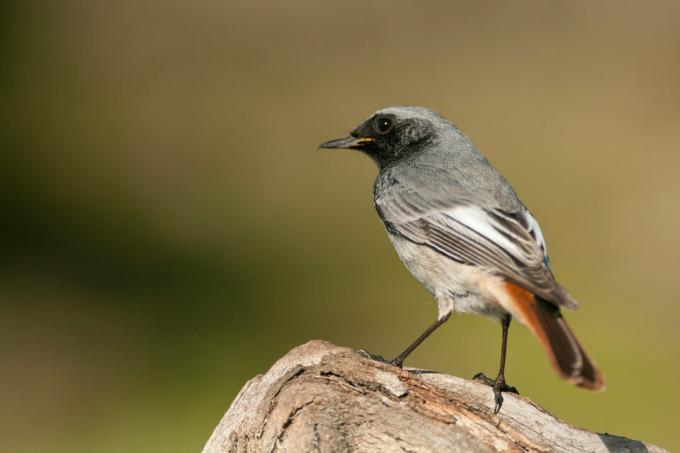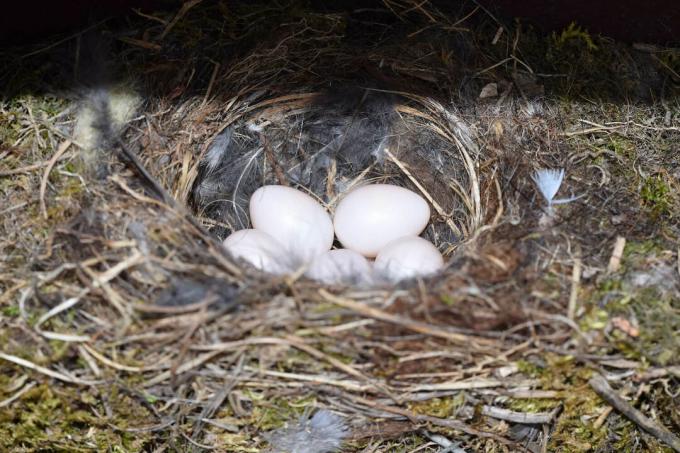What is the difference between the black redstart and the common redstart? How do you recognize a female black redstart and a young black redstart? We reveal this and more in our profile.

Few bird species like to get close to humans as the black redstart (Phoenicurus ochruros). The former rock dwellers have adapted very well to human habitats and are found in large numbers in cities, villages and domestic gardens. Early in the year you can hear the characteristic song of the birds echoing from the roofs and see the little redtails jumping over lawns. Black redstart are not endangered in their population and are much more common than the closely related ones Redstart. Here you can find out how you can do something good for the pretty songbirds, how you can clearly identify them and differentiate between males and females.
contents
- Black redstart: wanted poster
-
This is how you recognize the black redstart
- What does black redstart singing sound like?
- How do you recognize a young black redstart?
- What do black redstart eggs look like?
- How do black redstart females and males differ?
- How do the redstart and the redstart differ?
- Which habitat do black redstart prefer?
- Where does the black redstart build its nest?
- When is the black redstart breeding season?
- Where do the black redstart spend the winter?
-
Support the black redstart in the garden: this is how it works
- What do black redstart eat?
- Which nesting boxes are suitable for black redstart?
- How can you additionally support the black redstart?
Black redstart: wanted poster
| size | Approximately 14-15 cm |
| weight | Up to 20 g |
| Breeding season | May June |
| lifespan | About 5 years |
| habitat | Open and semi-open landscapes, settlements and cities |
| Feed preference | Insects and spiders |
| Threats | Decline in food and living space |
This is how you recognize the black redstart
As the name suggests, the black redstart can be recognized by its bright rust-red tail. The rest of the plumage is rather dark. The males are - especially in the face and chest area - almost jet black. The only other splash of color are the white fields on the wing covers. The animals like to sit on roofs or other elevated structures and sometimes even seem to be standing in the air - similar to a hummingbird.

What does black redstart singing sound like?
The black redstart has a distinctive and unique song. This begins with a short series of high, loud tones, then turns into a pressed crunch and ends in a few trilling closing tones: "Ti-ti-ti-ti-krrrsch-schrr-tli-tli-li ".
You can hear the black redstart singing in this recording:
In addition, the black redstart also has some calls that are uttered when excited or in danger: "Si", "Fid" or "Tek-tek-tek".
How do you recognize a young black redstart?
Young black redstart tend to be inconspicuous. They are uniformly gray-brown in color and therefore resemble the female animals. However, the red tail is already clearly visible. Based on this characteristic, the young birds can be clearly assigned.

What do black redstart eggs look like?
The black redstart female lays four to six white, approximately 2 centimeters large eggs per clutch. The nest is cup-shaped and consists of tightly packed stalks, leaves, moss and other plant fibers. The eggs are embedded in a deep nest hollow that has been padded with feathers and hair.

How do black redstart females and males differ?
Black redstart females and males can be distinguished very well. The females are much lighter than the males and have gray-brown plumage all around. The red tail is their only feature that allows them to be clearly identified as a black redstart, which sometimes only becomes visible when it flies up. During the breeding season, however, mix-ups can occur: If the young are already partially grown, they look very similar to the female black redstart regardless of gender.

How do the redstart and the redstart differ?
Even if the common redstart has become much rarer than the black redstart, both species occur in our country. As the names suggest, they share the rust-red tail. Apart from that, however, one can easily distinguish them. In the common redstart males, the rust-red color of the tail extends to the breast, which makes them appear much lighter than the black redstart. In addition, the redstart's face is adorned with a bright white stripe over the eyes. It is a little more difficult to differentiate between females, but generally redstart females are also lighter than their relatives and slightly red on the belly.
Which habitat do black redstart prefer?
The black redstart colonizes a multitude of habitats up to high mountain regions. He lives in open and semi-open landscapes, but also in villages and towns. Where there are no rocky structures as nesting sites, quarries, buildings and walls are also accepted. He only avoids densely forested areas.
Where does the black redstart build its nest?
The black redstart naturally breeds in rocky landscapes in natural niches or caves. However, the majority of individuals today live close to people and use wall niches, facade holes and a variety of other structures, such as mailboxes, as nest locations. The female alone takes care of the selection of this location and the actual nest building. The size of the nest is adapted to the circumstances.

When is the black redstart breeding season?
Just like building the nest, the female also takes on the task of brooding. The black redstart breeding season begins in May and usually ends in June. During this time the breeding pairs create one or two broods. The incubation period is about 14 days. Then the young birds hatch and stay in the nest for another two weeks. During this time they are fed by both parents. And even after they have flown out, the boys are supported by their parents for up to three weeks before they are left to fend for themselves.
Where do the black redstart spend the winter?
The black redstart leave us over the cold winter months. The small songbirds migrate towards the Mediterranean and overwinter mainly north of the Sahara. However, they will start their homecoming in January, which means that they will be our guests again at the beginning of March.
Note: As a result of the mild winters in recent years, it is more and more common that black redstart overwinter in southern Germany and do not even move to the south.

Support the black redstart in the garden: this is how it works
Black redstart are fun fellows who sing tirelessly and like to sit on fences and other freestanding ridges. If you want to offer the little songbirds a home, you will find tips below for implementing them in your own garden.
What do black redstart eat?
The black redstart feeds mainly on insects and spiders. Berries and other fruits are rarely used. The hunters often look out from elevated waiting areas and then pounce on their prey from above. However, they also hop through low vegetation in search of small animals living on the ground. And sometimes they perform a so-called shaking flight, in which the birds stand in the air and pick insects from trees, walls or rocks.

Since most black redstart escape the cold winters, they do not benefit from well-intentioned winter feeding. In summer, however, the songbirds enjoy a rich supply of insects. The design of a insect-friendly garden can work wonders here. Creating a meadow with local flowers, for example, can generate an entire habitat for a large number of small garden animals. With our Plantura beneficial insect magnet you can implement such an insect paradise quickly and easily. And it's not just the birds who will thank you. With this seed mix, you will also attract useful pollinators and pest killers to your garden.
Which nesting boxes are suitable for black redstart?
If you want, you can offer a nesting box for black redstart in your garden. Although these are not preferred, they are gratefully accepted if there are no nesting opportunities. The redstart prefer so-called half-cave boxes, which have a large entrance opening on the front. And if you have old buildings or walls on your property that have one or the other hole, think carefully about whether you need to fill this - if not, the black redstart will to thank.

Tip: A Build your own nest box is not that difficult and guarantees handicraft fun for the whole family.
How can you additionally support the black redstart?
When designing an insect and bird-friendly garden, it is of course always important to keep away toxic substances. Avoid the use of chemical sprays in your garden and pay attention too in your daily shopping on which agricultural cultivation method you would like to support. Because pesticides are still one of the main reasons for the decline in insects.
On hot summer days, the little songbirds also enjoy a watering hole. It doesn't necessarily have to be a magnificent bird bath - a flat bowl or trivet is sufficient. Incidentally, these also work as a bird bath, because there is no real difference between bath and drinking trough. It is only important that the water point is cleaned regularly to prevent the transmission of infectious diseases. The bowl should therefore be cleaned daily, especially on hot days.
If you would like to find out more about the most common garden birds, then browse through our other species portraits and learn something about House sparrows or Wagtails.



